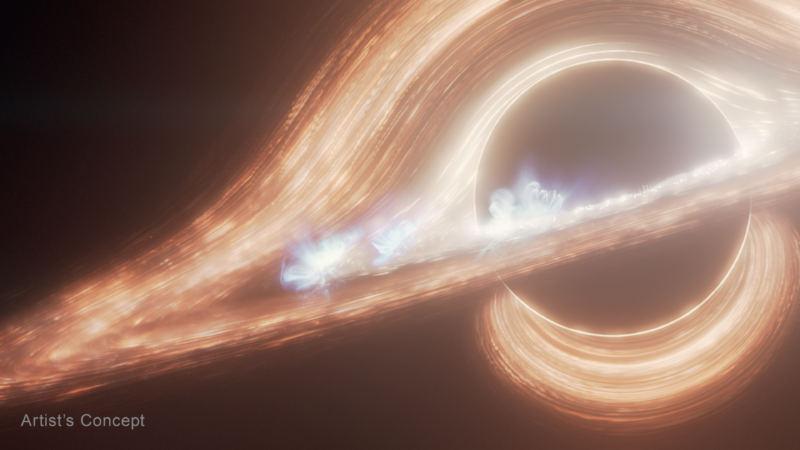Why are ‘fireworks’ coming from a black hole? This is what scientists say
A supermassive black hole in the center of the Milky Way galaxy is creating a light show that’s intriguing astronomers.
Flares of light have been observed in a disk orbiting the black hole Sagittarius A*, according to a team of astrophysicists studying the black hole who published their findings Tuesday in The Astrophysical Journal Letters. Known as an accretion disk, it’s hot, contains a steady flow of materials like gas or plasma, and flickers constantly. The disks emit light that can be detected using infrared and X-ray instruments, which helps astronomers better observe the black holes the disks orbit.
The flares are common in supermassive black holes and have been seen before, says Farhad Yusef-Zadeh, a professor of physics and astronomy at Northwestern University who led the study. But the ones found in Sagittarius A* are unique, he says. That’s because they occur in much shorter durations than those observed in other supermassive black holes. Sagittarius A* is also unique because it is 26,000 light years away from Earth — which is considered close in outer space.
The flares and flickers around Sagittarius A* also varied in brightness and duration, with the brightness of the flares changing from hours, to minutes, to seconds.
“Since multiple flares come one after another, it is like a firework happening before it goes quiet. This happens a few times a day,” Yusef-Zadeh tells NPR.
Images of the faint flickers and big, bright flares around the black hole taken from nine hours of observation by the telescope can be seen in a time-lapse video released by Northwestern University.
The weaker flickers are common and caused by less intense changes throughout the disk. But the bright, large flares are thought to stem from more turbulent changes that are very intense, with high magnetic fields and high pressure. This can cause those magnetic fields to collide and release energetic particles close to the speed of light, giving off bright bursts of radiation that are ejected outward, similar to that of a solar flare from the sun, Yusef-Zadeh says.
A better understanding of black holes
Yusef-Zadeh and other astrophysicists were able to study the flares using NASA’s James Webb Telescope’s NIRCam (Near-Infrared Camera), a powerful instrument so sensitive that it can detect light from the universe’s earliest stars. Using this camera, the team observed the black hole and its changes for multiple hours a day, totaling 48 hours in one year between 2023 and 2024.
Studying flares in accretion disks like those of Sagittarius A* can help scientists learn more about black holes in general, says Dr. Moiya McTier, an astrophysicist.
“These flares can also give us insight into the magnetic activity of black holes and not just their mass or gravity activity,” McTier tells NPR. “Black holes are still, at their core, a mystery. We know that they are big dense objects and that they attract other things to them through gravity, but we haven’t gotten close to a black hole.”
Understanding both the flares and black holes is also important because it will help scientists test scientific theories, including predictions in Albert Einstein’s general theory of relativity, Yusef-Zadeh says.
“Our galactic center, the supermassive black hole, is really a fantastic laboratory to test some of the ideas that are around and people have predicted,” he says. “My hope is that we get a better understanding of why the accretion flow is changing all the time.”
How good was the forecast? Texas officials and the National Weather Service disagree
As searchers continue to look for victims in the deadly flash flooding in Texas, officials are answering questions about the weather forecasts ahead of and during the storm.
Video: Timelapse Shows Texas’ Llano River Completely Flood in Just Minutes
Timelapse video shows authorities blocking off a low water crossing over the Llano River in Kingsland just before flash flooding completely inundated the area in just 10 minutes.
Musk forms new party after split with Trump over tax and spending bill
Musk said he's carrying out his threat to form a new political party after a falling out with Trump over the president's sweeping tax cuts law.
Knives, bullets and thieves: the quest for food in Gaza
NPR's Gaza producer faced Israeli military fire, private U.S. contractors pointing laser beams at his forehead and masked thieves as he tried to get food from a U.S.-supported group.
4 things to know about the vaccine ingredient thimerosal
Advisers to the Centers for Disease Control and Prevention recommended against flu shots containing the ingredient thimerosal. Why is the additive, safely used since the 1930s, being questioned again?
Tropical Storm Chantal strengthens slightly as it nears landfall in South Carolina
Tropical Storm Chantal grew in strength as it approached the southeast U.S. coast. It's forecasted to bring heavy rains to parts of the Carolinas on Sunday.







